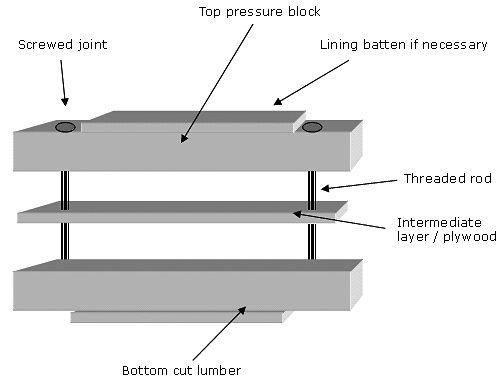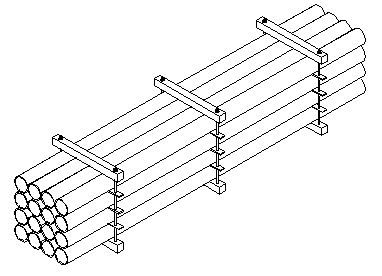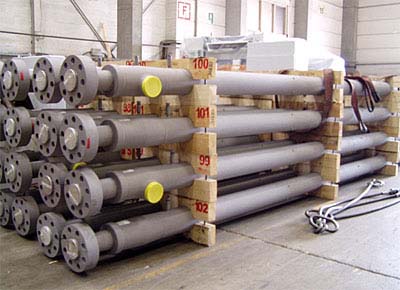Long goods are bundled. The most expedient way of bundling long goods is to use cut-lumber clamps with threaded rods as tensioning elements. This method combines tight-fit and friction securing techniques. 
Figure 101: Construction of a cut-lumber clamp The long goods are arranged in layers separated by intermediate layers of plywood with weatherproof glues and clamped between the cut-lumber. The tensioning elements, namely the threaded rod/screw elements, must be constructed in such a way that the heads are recessed in pocket holes in the pressure block or the bottom beam. Alternatively, any protruding elements must be compensated for by nailing on lining battens to prevent any nuts or threaded rods which may cause problems during storage handling from protruding. The pocket holes in the cut lumber must be designed in such a way that sufficiently large plain washers and lock washers can be inserted under the nuts. The tension forces exerted by the two cut lumber elements must be sufficient to prevent the long goods from escaping. It may be necessary to use additional friction-enhancing intermediate layers between the individual layers of goods to secure them. The moisture content on processing the lumber for the clamps must not be higher than 20 % in order to ensure that tension is not lost as the lumber dries and shrinks. The cut-lumber clamps must protrude by at least 10 cm in order to take the tensioning screw. Threaded rods must have a diameter of at least 12 mm (M12). Bundling individual long goods makes a package that retains a stable form and is equally suitable for handling with ground conveyors or cranes. If the long goods have specially treated surfaces, protection against chafing must be provided in the form of a layer of boards beneath the bottom layer and between the cut-lumber clamps at the point at which the forks are inserted. Under certain circumstances, the ends of the bundled long goods must be protected by end cladding that is retained by the clamps. A bundle must be retained by at least three clamps. In the case of sensitive, cylindrical long goods, the pressure blocks must be shaped to accommodate the goods either by cutting recesses or by using wedges. In the case of long materials with sensitive surfaces, constructional measures must be taken to protect them in the vicinity of the slinging and handling points. 
Figure 102: Example of bundling with a cut-lumber clamp, schematic diagram 
Figure 103: Example of bundling with cut-lumber clamps Each of the clamps has been shaped to match the cylindrical form of the long goods. |
| Top of pageContents |
